The New Wywires Gold Interconnect Cable: A New Standard?
|
|
|
February, 2013 |
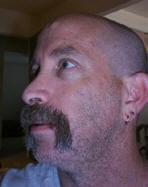 If you look closely at the Wywires Gold XLR interconnect I reviewed some months ago [here], and then look closely at the latest version of this interconnect, the Series 3, you probably won’t notice any difference—same exotic Xhadow plugs, same woven black polyester sleeve, same gold-toned Mylar serving winking through the loose weave of the sleeve. If you have a particularly good eye for spatial relationships or the tactile sensitivity of a card sharp, you might notice that the new cable seems slightly thicker. And that’s because it is, containing more wires than its predecessor.
If you look closely at the Wywires Gold XLR interconnect I reviewed some months ago [here], and then look closely at the latest version of this interconnect, the Series 3, you probably won’t notice any difference—same exotic Xhadow plugs, same woven black polyester sleeve, same gold-toned Mylar serving winking through the loose weave of the sleeve. If you have a particularly good eye for spatial relationships or the tactile sensitivity of a card sharp, you might notice that the new cable seems slightly thicker. And that’s because it is, containing more wires than its predecessor.
For those of you who, like myself, are curious about all sorts of non-essential details that go into making a particular audio component, the Series 2 Gold interconnect consisted of 10 strands of 38 gauge litz copper wire for hot, 12 strands of 36 gauge litz copper wire for return, and a stranded 24 gauge, non-litz copper wire for ground. The Series 3 roughly doubles this with 20 strands of 38 gauge for hot, and 22 strands of 36 gauge for return. The wire-bundle servings are organic cotton rather than the nylon used in the Series 2. The use of cotton is a good thing. Cotton has a better dielectric constant than nylon, closer to that of air, and air is about as good as you can get on the surface of planet Earth. From an audiophile’s viewpoint, dielectric constant boils down to a simple concept: how much capacitive charge (and consequent time smear) a contiguous surface can hold. This varies with the material used in the serving and, presumably, it also varies with the weave of the serving. The airier the weave, the closer the overall capacitive behavior is to that of air.
Each of the two cotton-insulated legs of the cable is installed inside a Teflon (PTFE) tube so there is a significant amount of air space, and all three legs are surrounded with a woven, gold-toned Mylar serving which in turn is inside a protective, braided black polyester sleeve. The cables are on the stiff side but are relatively thin and flexible enough. Standard cable length is 4 feet with a capacitance of 5.9pF per foot. (As a comparison, Nordost Odin Supreme Reference interconnects are 19pF per foot.)
Litz wire is composed of multiple, individually insulated strands. This is accomplished by coating each strand with a liquid insulator (in this case Dupont Nyleze), allowing this to dry, then bundling the strands, sometimes in an elaborate pattern to equalize strand length throughout the wire bundle. Insulating multiple fine strands in this way reduces proximity and skin effects. For details I refer you to my earlier reviews of Wywires cables, or to the half-million-plus hits “litz wire” generates in a Google search. Though I’m not sure that reading every last thing on the subject would convince you that litz wire is, or is not, the best choice for an audio interconnect. Some audio cable manufacturers use it (eg., Cardas, LessLoss, Wywires) but the majority do not. Litz wire is more expensive, harder to find in specific gauges, and more difficult to work with. As for natural fiber servings, it’s even more uncommon than litz wire, in part because such servings are not readily available in specific diameters and weaves, and in part because using man-made insulation is simpler, less expensive and more durable. And of course not every designer thinks natural fiber a good idea. Most prefer Teflon.
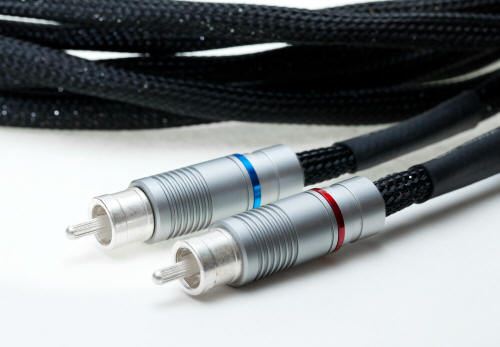
The Xhadow connector at the distal end of each cable contains a Bybee Slipstream Quantum Purifier, as did the Series 2. If my experience with Jack Bybee’s devices is anything to go by, the remarkable difference between the Wywires Silver and Gold interconnect is due mainly to the presence of the Slipstream Purifier in the latter. This is what makes the Gold series golden. All connections are soldered with WTB silver-bearing solder. Silver-bearing solder is a better conductor, contains fewer impurities and costs a lot more than tin/lead solder. And no doubt there are those whose aural discernment is so keen that they can detect the differences between silver-bearing and standard solder. But whether one can hear this or not, it is encouraging to know that a manufacturer is willing to go to the trouble and expense of executing a design in the best way feasible.
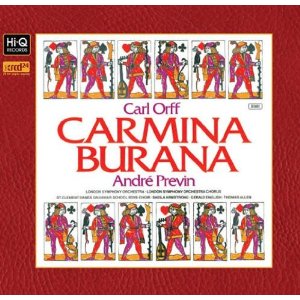
Carl Orff: Carmina Burana, London Symphony Orchestra, et al, André Previn, conducting (Hi-Q Records HQXRCD8). You may notice, buried in the catalog number of this CD, the letters X, R, C and D. If this puts you in mind of Japan Victor Corporation’s now defunct XRCD series, you are spot on. Hi-Q Records, a London-based company, had the original analog tapes of this classic Carmina digitized, remastered and manufactured by the JVC Mastering Center in Japan. XRCD lives! If you don’t think this is a big deal, I refer you to my review in this venue comparing standard CD and XRCD versions of Bartok’s Concerto for Orchestra. Digital word for word, the data on these discs is identical (in theory, I did not run a byte by byte comparison), but the sound quality definitely is not.
With this new version of the Wywires Gold, cable dynamics and speed are improved; the horns have a more realistic bite. There is a greater sense of—how shall I put this—acoustical, rather than electronic, presence. This last, which may read like gibberish, has to do with what you might call accurate, unenhanced ambient retrieval. The experience of a live hall is often remarkably different than the experience of a living room stereo. Even taking into account the numerous acoustic variables involved, the vicissitudes of engineering and manufacture, the differences in electronics, there is often an “artificial” brightness and vivacity in the home stereo that may be exciting and pleasurable in its own right, but doesn’t convey the organic quality of a great hall. XRCDs, based as they have traditionally been on analog tapes, excel in this regard. And the Series 3 cables seem to do a subtly but significantly improved job of keeping the signal neutral and unembellished.
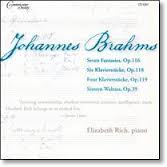 Johannes Brahms: Fantasies, Klavierstüke, Waltzes, Elizabeth Rich, piano (Connoisseur Society CD 4267). Ms Rich’s abundant heart and talent are as evident here as they were in her recording of the complete Mozart sonatas, reviewed a few years ago in this venue. I have lost count of the times I’ve played this new release from Connoisseur, but I continue to be impressed with the meticulous care that went into the performance, the profound understanding, the emotional accuracy. And as for the late Johannes Brahms, this music (most of it written when he was an old man) is simply wonderful and his unique emotional sensibilities, his deep and abiding passions could not have found a better exponent than Elizabeth Rich. The venue for this recording, as for the Mozart, is the First Presbyterian Church in Utica, a town in upstate New York noteworthy for the Munson-Williams-Procter Institute, for bitter-cold, snow-filled winters, for superb submarine and meatball sandwiches, and for the fact that I had a flat there for several years prior to journeying to the promised-land north and west of the Pecos.
Johannes Brahms: Fantasies, Klavierstüke, Waltzes, Elizabeth Rich, piano (Connoisseur Society CD 4267). Ms Rich’s abundant heart and talent are as evident here as they were in her recording of the complete Mozart sonatas, reviewed a few years ago in this venue. I have lost count of the times I’ve played this new release from Connoisseur, but I continue to be impressed with the meticulous care that went into the performance, the profound understanding, the emotional accuracy. And as for the late Johannes Brahms, this music (most of it written when he was an old man) is simply wonderful and his unique emotional sensibilities, his deep and abiding passions could not have found a better exponent than Elizabeth Rich. The venue for this recording, as for the Mozart, is the First Presbyterian Church in Utica, a town in upstate New York noteworthy for the Munson-Williams-Procter Institute, for bitter-cold, snow-filled winters, for superb submarine and meatball sandwiches, and for the fact that I had a flat there for several years prior to journeying to the promised-land north and west of the Pecos.
The Series 3 cables provide a particularly pellucid and nuanced image of the Yamaha CFIIIS piano. In line with the cable designer’s comment to me, the bass is noticeably improved compared with the Series 2, having a clearer attack and richer harmonics as well as a more robust fundamental. It’s as if the cables are delivering transient information with greater speed and accuracy. The treble strings have beautiful clarity and ringing overtones. Risking the wrath of the Steinway-loving majority, I must say that I find the Yamaha to be a glorious instrument, and very well served by these new cables.
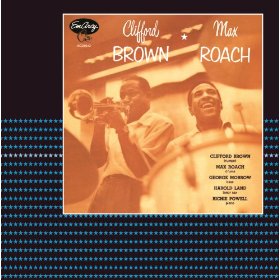 Clifford Brown and Max Roach (Verve Master Edition 314 543 306-2). I’m always on shaky ground when it comes to jazz. There just is not, as Andrew Marvell said in a wholly different context, ‘world enough and time’ for all the things that interest and delight, so while I have acquired some small knowledge of classical music and classical recordings, I have far less knowledge of jazz and jazz recordings. (Except that the emotional honesty and astonishing musicianship of good jazz are sometimes just what I need. And regarding musicianship, one would have to search far and wide to find a musician, in any venue, of Max Roach’s or John Coltrane’s or Duke Ellington’s caliber—to name but three.) But it’s hard to believe this recording is nearly 60 years old. If the job of a stereo is to create the illusion that you are there, this CD rides near the top. Which inevitably raises some perfectly reasonable questions about the state of sound and recording engineering these days. This CD may sound a bit shy on treble, but followed by any number of more recent jazz recordings, there is no question which of the discs is more realistic, which of them makes me feel more like I’ve stepped into a basement club. The only things missing are coughing and the tinkle of ice. And this further illustrates two improvements in the Series 3 Wywires interconnect, a retrieval of nuanced information that elevates this recording to sublimity, and a blanket neutrality that shows up everything a particular CD has to offer, warts as well as beauties.
Clifford Brown and Max Roach (Verve Master Edition 314 543 306-2). I’m always on shaky ground when it comes to jazz. There just is not, as Andrew Marvell said in a wholly different context, ‘world enough and time’ for all the things that interest and delight, so while I have acquired some small knowledge of classical music and classical recordings, I have far less knowledge of jazz and jazz recordings. (Except that the emotional honesty and astonishing musicianship of good jazz are sometimes just what I need. And regarding musicianship, one would have to search far and wide to find a musician, in any venue, of Max Roach’s or John Coltrane’s or Duke Ellington’s caliber—to name but three.) But it’s hard to believe this recording is nearly 60 years old. If the job of a stereo is to create the illusion that you are there, this CD rides near the top. Which inevitably raises some perfectly reasonable questions about the state of sound and recording engineering these days. This CD may sound a bit shy on treble, but followed by any number of more recent jazz recordings, there is no question which of the discs is more realistic, which of them makes me feel more like I’ve stepped into a basement club. The only things missing are coughing and the tinkle of ice. And this further illustrates two improvements in the Series 3 Wywires interconnect, a retrieval of nuanced information that elevates this recording to sublimity, and a blanket neutrality that shows up everything a particular CD has to offer, warts as well as beauties.

Specifications:
Analog Interconnect Cables – 4 ft standard length (1.23 meters)
Capacitance: 5.9 pF (per foot at a frequency of 10 kHz)
Gold Priced from $1399 (includes ByBee Slipstream Purifiers)
Above prices are for products sold in the US only. Prices outside the US are higher, and subject to taxes and duties depending on the country of sale.
Contact: Wywires
16501 Sherman Way, Suite 120
Van Nuys, CA 91406 (Los Angeles)
818.981.4706
website: www.wywires.com
Email: info@WyWires.com
Associated Equipment:
Analog Front End
Rega Planar 3, Benz Glider
Digital Front End
BelCanto CD2 and DAC 3.5VB Mk II
Amplification
Bel Canto DAC3.3 VB, Audible Illusions Modulus 3A, Bel Canto REF1000 MkII
Loudspeakers
NSMT Armada System: 20M Monitors,
Sandbag Stands, 15EXP Subwoofers
Cabling
LessLoss Signatures
Digital cable: Wywires, Lessloss
Interconnect cables: Wywires
Speaker cable: Nordost Flatline Gold
Acoustic Revive Reference Power AC cords.
AC Conditioners
Acoustic Revive RTP-4
Accessories
Spike Sound Iso Feet, Acoustic Revive quartz pucks, Acoustic Revive Schumann generator
![]()
Stereo Times Masthead
Publisher/Founder
Clement Perry
Editor
Dave Thomas
Senior Editors
Frank Alles, Mike Girardi, Russell Lichter, Terry London, Moreno Mitchell, Paul Szabady, Bill Wells, Mike Wright, and Stephen Yan,
Current Contributors
David Abramson, Tim Barrall, Dave Allison, Ron Cook, Lewis Dardick, John Hoffman, Dan Secula, Don Shaulis, Greg Simmons, Eric Teh, Greg Voth, Richard Willie, Ed Van Winkle, Rob Dockery, Richard Doran, and Daveed Turek
Site Management Clement Perry
Ad Designer: Martin Perry


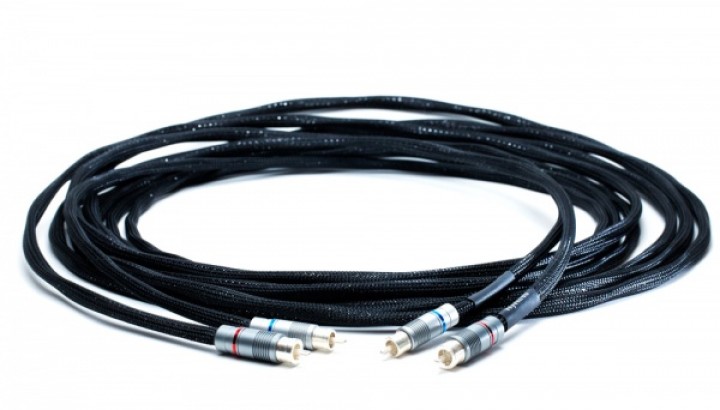



Be the first to comment on: The New Wywires Gold Interconnect Cable: A New Standard?